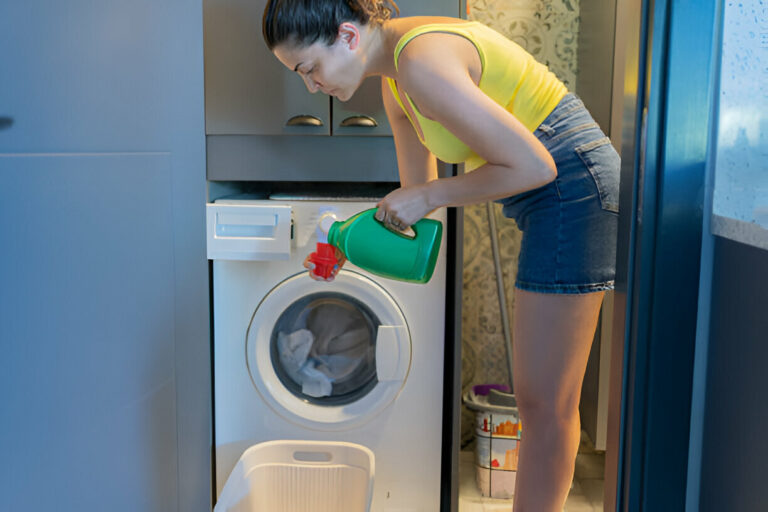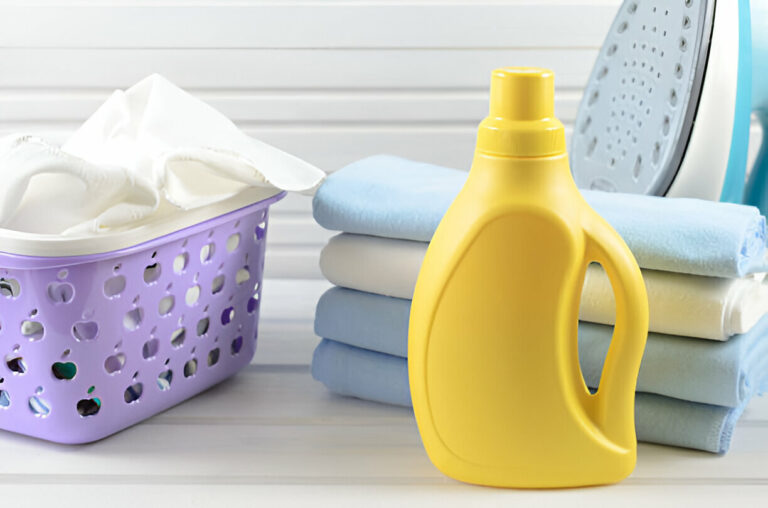- 3437 15th Ave S. St. Petersburg, FL 33711
- +1 (727)-335-7190
Tired of dealing with bleach mishaps and the confusion of how to properly care for your clothes? Skip the hassle and let CleanFold Laundry handle it. Schedule a professional pickup laundry service today and get your clothes expertly cleaned and returned—fresh, safe, and ready to wear.
Have you ever looked at your white clothes and thought, “How can I make them look bright and new again without damaging them?” You’re not alone. Many people in St Petersburg face the same challenge of keeping their clothes fresh and spotless. Whether you’re dealing with stubborn stains or fading whites, there’s a solution that can help!
The answer? Bleach.
Bleach is an effective tool for brightening whites, removing tough stains, and even disinfecting your clothes. However, using bleach incorrectly can lead to discoloration or fabric damage.
In this step-by-step guide by CleanFold Laundry Experts, we’ll walk you through how to safely and effectively use bleach to bring your laundry back to life.

Many people believe bleach is only for whitening clothes, but it’s much more versatile than that! In fact, bleach is a powerful multi-use laundry product that can:
But not all fabrics are bleach-safe. Using the wrong bleach or improper methods can lead to unwanted yellowing or even fabric damage. That’s why it’s essential to know when and how to use bleach the right way.
When it comes to laundry, two types of bleach are commonly used: Chlorine Bleach and Oxygen Bleach. Understanding the difference between them is key to using bleach safely and effectively.
Chlorine bleach is a powerful disinfectant and whitener. It’s ideal for whitening white clothes, especially cotton, and for sanitizing towels and bedding. However, it can be harsh on fabrics, weakening fibers over time.
Oxygen bleach is a gentler alternative that is safe for a wider range of fabrics, including colored clothes. It works well to brighten whites and remove stains without the harsh effects of chlorine bleach.

While bleach is a useful laundry product, it’s not necessary for every wash. Knowing when to use bleach will help you achieve the best results without damaging your clothes. Here are the ideal situations to reach for bleach:
To brighten yellowed or grayed white garments: Bleach can help restore your whites and make them look fresh again.
When sanitizing towels, baby items, or linens: Bleach disinfects, ensuring that your towels and linens are germ-free.
To remove stubborn stains: If you’re dealing with mildew, sweat, or mold, bleach can be your best friend in fighting these tough stains.
For cleaning specific spots: Use bleach to target problem areas, like collars or underarms, where stains accumulate.
To sterilize heavily used household items: Items like cleaning rags or mop heads that need disinfecting can benefit from bleach.
On fabrics like silk, wool, or spandex: These materials are too delicate and may get damaged.
On dark or light-colored clothes (unless using color-safe bleach): Chlorine bleach can cause fading or color loss on non-white garments.
On clothes with metallic trims or elastic edges: These details can degrade or discolor with bleach.
Understanding the difference between Chlorine Bleach and Oxygen Bleach is crucial for using the right product in your laundry. Each has its strengths, so let’s break down when to use each:
Chlorine bleach is a strong and effective option, ideal for sanitizing and whitening white garments. It works best on cotton and synthetic fabrics and is perfect for disinfecting towels, bed linens, and other heavily soiled items.
Oxygen bleach is gentler and more versatile than chlorine bleach, making it ideal for colored fabrics and delicate materials. It brightens whites without the harsh effects of chlorine bleach and is gentle on the fibers.
Using bleach correctly ensures that you get the best results without damaging your clothes. Follow this simple guide to safely add bleach to your laundry routine:
Step 1: Read Care Labels
Always check the care label on your clothing before using bleach. Look for the bleach symbol:
Empty Triangle: Bleach can be used.
Triangle with Diagonal Lines: Use only non-chlorine bleach.
Triangle with X: Do not use bleach.
Step 2: Choose the Right Bleach
For white cotton or polyester: Chlorine bleach works best.
For colored clothes or delicate fabrics: Oxygen bleach (color-safe bleach) is your best bet.
Tip: Popular oxygen bleach brands include OxiClean and Seventh Generation.
Step 3: Dilute the Bleach
Never apply bleach directly to clothing. Always dilute it in water to avoid damage. Here’s how:
For top-load washers:
For front-load washers:
For hand washing:
Step 4: Run the Wash Cycle
Use the hottest water temperature allowed by the fabric care label. Choose a normal or heavy-duty cycle for best results.
Important: Avoid overusing bleach. Too much can leave a residue on your clothes.
Step 5: Rinse Thoroughly
To avoid skin irritation, make sure to rinse your laundry thoroughly after using bleach. If washing towels or baby clothes, consider running a second rinse cycle to remove any remaining bleach.
Using bleach safely ensures you protect your clothes and keep your laundry routine hassle-free. Here are some essential tips to follow:
1. Never Mix Bleach with Other Chemicals
Avoid mixing bleach with ammonia or vinegar. Combining these can produce toxic fumes that are hazardous to your health and can irritate your skin and eyes.
2. Use Bleach in Well-Ventilated Areas
Always bleach in a well-ventilated space. Open windows or use fans to avoid inhaling the toxic fumes that bleach releases.
3. Wear Protective Gear
When handling bleach, wear gloves to protect your skin. Bleach can cause irritation, especially if it comes into direct contact with your hands.
4. Measure Bleach Carefully
Never “eyeball” your bleach measurements. Too much bleach can cause damage to clothes and leave residue behind. Use a measuring cup for accuracy.
5. Keep Bleach Out of Reach
Store bleach in a safe, well-ventilated location out of reach of children and pets. Be sure to seal the container tightly to avoid spills or leaks.
Whites naturally fade and dull over time, but bleach can help restore them to their original brightness. However, it’s important to use bleach correctly to achieve the best results without damaging the fabric.
Tips for Bleaching White Laundry:
Sort Whites Separately: Always wash white clothes separately to avoid any accidental color transfer from other garments.
Use Hot Water: For optimal results, wash whites in hot water (unless the care label advises against it). The heat helps activate the bleach and enhances its brightening effect.
Add Bleach and Detergent Separately: Always add bleach and detergent at different times to avoid a chemical reaction that could damage the fabric.
Sun Dry for Maximum Whitening: After washing, hang your white clothes in the sun. The UV rays will help naturally bleach and freshen up your clothes without the use of additional chemicals.
Pro Tip:
Avoid using bleach on white items with patterns, seams, or colored threads. The bleach may discolor the colored portions of the fabric, leaving behind unsightly stains.
While bleach can be incredibly effective at whitening clothes and removing stains, it’s important not to overuse it. Too much bleach can weaken fabrics and cause them to wear out faster. Here’s a safe frequency guide to help you use bleach without damaging your clothes:
Recommended Frequency for Different Items:
Tip for Fabric Longevity:
Pair bleach with gentler alternatives like vinegar or baking soda to maintain fabric quality over time. This will help preserve the lifespan of your clothes while still achieving the cleanliness and brightness you want.

If you’re looking for a greener, gentler way to brighten and sanitize your laundry, there are several alternatives to traditional bleach. These options can help refresh your clothes without the harsh chemicals, making them perfect for delicate fabrics or anyone looking for an eco-friendly solution.
1. Hydrogen Peroxide (3%)
Hydrogen peroxide is a natural disinfectant and bleaching agent that’s perfect for laundry. It’s effective at brightening whites and removing stains, without the harshness of chlorine bleach.
Best for:
2. White Vinegar
White vinegar is a great natural fabric softener and brightener. It helps to remove odors, brighten whites, and even soften fabrics, making it a perfect, chemical-free alternative to bleach.
Best for:
3. Lemon Juice
Lemon juice is a mild bleaching agent that works well on whites. Its natural acidity can help lift stains and brighten your laundry, while leaving behind a fresh, clean scent.
Best for:
4. Sun Drying
Did you know that the sun can naturally bleach your whites? Hanging your laundry outside on a sunny day allows the sun’s UV rays to naturally whiten and freshen your clothes.
Best for:
Even laundry experts can make mistakes when using bleach. To ensure your clothes stay looking great and are properly cared for, avoid these common bleach errors:
1. Pouring Bleach Directly on Clothes
Never pour bleach directly onto clothing. This can lead to uneven bleaching, fabric damage, or discoloration. Always dilute bleach in water first.
2. Using Bleach on Colored Clothes (Without Color-Safe Bleach)
Chlorine bleach can cause colors to fade or bleed. Always use oxygen bleach (color-safe bleach) for colored garments to avoid damaging the fabric.
3. Using Too Much Bleach
More bleach doesn’t mean cleaner clothes. Overusing bleach can weaken fabrics and leave residues on your clothes, which can irritate your skin. Always follow the recommended dilution ratios.
4. Mixing Bleach with Other Cleaning Products
Mixing bleach with ammonia, vinegar, or other cleaning products can create dangerous toxic fumes. Always use bleach alone and never mix it with other chemicals.
5. Ignoring Care Labels
Not all fabrics can handle bleach. Always check the care label on your clothes before using bleach. If it says “Do not bleach,” heed the warning to prevent fabric damage.
At CleanFold Laundry, we know that bleach can be tricky, especially when dealing with delicate fabrics or busy schedules. That’s why we take extra care with each load to ensure the best results.
For our local clients, we offer professional pickup laundry services in St-Petersburg , Palm bay and Melbourne that include gentle, bleach-free options for delicate fabrics, or we can apply safe bleach treatments when requested.
If you’re worried about using bleach at home or need help with tough stains, leave it to the experts! We’ll take care of your laundry with the utmost care, ensuring it’s clean, fresh, and safe from damage.
Extra Services:
Simply let us know about any fabric concerns, and our team will handle the rest with precision and care.
Using bleach in your laundry doesn’t have to be intimidating. When used correctly, bleach can effectively sanitize, brighten, and remove tough stains, making your whites look fresh again. Just remember to always read clothing labels, use the right type of bleach for your fabrics, and dilute bleach properly to avoid any damage.
If you’re unsure about handling bleach or want to ensure your clothes are treated with the utmost care, let the experts at CleanFold Laundry help. Our professional laundry services ensure your garments are cleaned safely and effectively, leaving them looking their best.
Contact CleanFold Laundry today for all your laundry needs—whether you need bleach treatments, professional folding, or just a helping hand with your laundry routine. We’re here to make your laundry day easier and stress-free.